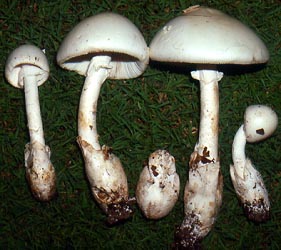|
[ Section Caesareae page. ]
[ Amanita Studies home. ]
[ Keys & Checklist/Picturebooks ] "Great White Slender Caesar" non Amanita egregia sensu A. E. Wood (1997) ?= Amanita egregina A. E. Wood [spelling corrected]
Technical description (t.b.d.) BRIEF DESCRIPTION: The cap of A. egregia is 100 - 200 mm wide, convex at first, then planoconvex to slightly depressed at the center, with a short sulcate-striate margin (20▒% of the radius in dried material), and slightly incurved at first. The cap is white when young, becoming pale brown over the disc, and shading to cream at the margin in mature specimens. The flesh is white. The volva is absent. The gills are narrowly adnate, close, and white. The short gills are truncate and extending up to 50% of the radius from the margin. The stem is 125 - 200 x 9 - 23 mm, white, fibrillose or furfuraceous, and cylindric or narrowing upward slightly. The flesh is white and stuffed. The saccate volva is ample and loosely sheathing. The spores measure (7.0-) 9.1 - 11.5 (-12.8) x (8.0-) 8.4 - 10.1 (-11.6) Ám and are subglobose to broadly ellipsoid and inamyloid. Clamps are present at bases of the basidia. Amanita egregia was originally described from the state of Queensland in northeastern Australia. A number of other species of stirps Hemibapha exist in this region, but not all have been described to date. The presence of species so similar to those of southeast Asia probably indicates their migration over a land bridge. They now are mycorrhizal with Eucalyptus as far as is known. This set of species do not appear to have migrated much beyond Queensland. More information on this group from Australia would be very welcome (contact). This species belongs in stirps Hemibapha. Within that stirps, it is among the taxa (mostly African and south Asian) that do not commonly have an umbo on the cap. The most similar taxa are A. chepangiana Tulloss & Bhandary, A. loosii Beeli, and A. zambiana Pegler & Piearce. -- R. E. Tulloss Photos: unknown photographer (top); Dr. Roy E. Halling (bottom).
[ Section Caesareae page. ]
[ Amanita Studies home. ]
[ Keys & Checklist/Picturebooks ] Last changed 2 October 2009. |

